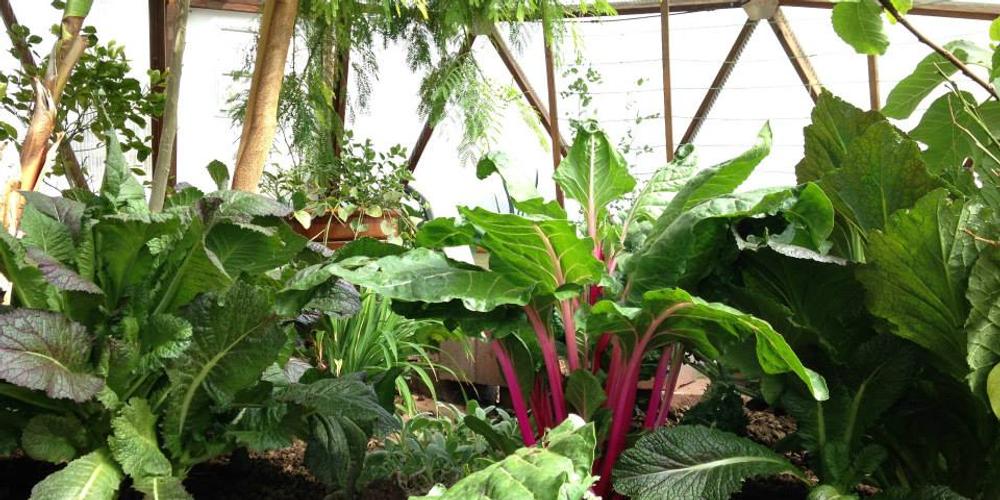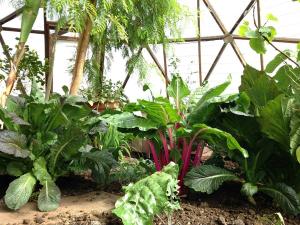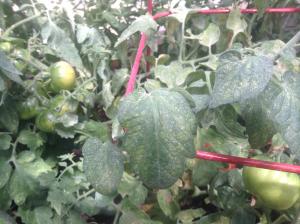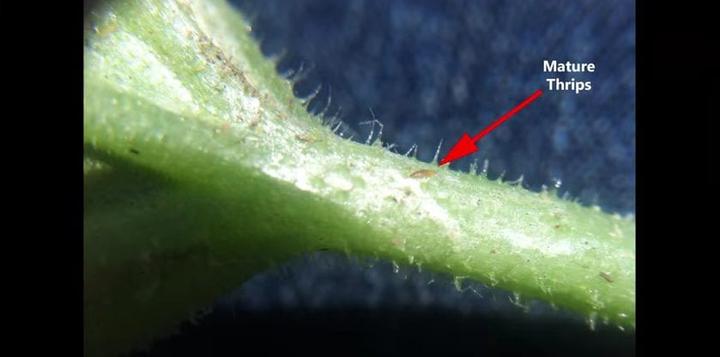
Organic Pest Control: Thrips
Organic Pest Control: Thrips

The plants in the Growing Dome were doing so well this year and then we started to notice some stippled leaves.
The tomatoes were hit first with spider mites once the rains stopped.
Spider mites thrive in hot, dry conditions. Unfortunately, they are not the only ones that love the heat.
The bean and melon leaves started to turn brown, stopped growing, and showed signs of stress. Even the blooms ceased.

Upon inspection, we found a flourishing population of thrips. A thrips here and a thrips there, they are everywhere! No need to fret yet.
There are approximately 6,000 known species of thrips to date. Of all those species, many are actually beneficial. Some happen to feed on mites. Others even feed on the spores of fungus. It is exciting to learn that these microscopic insects are more often than not WORKING FOR US. What a relief, right?
Sure, many species of thrips are truly a pest and not benefiting the plants we are trying to grow. So now what? Should we spray EVERYTHING and kill all insects? No Way! Or should we introduce beneficial insects? That might be a good idea!
Or better yet, let’s just let the natural world handle the issue for us. This sounds wonderful, so let’s dig in the soil and investigate what we need to do to make this happen with organic pest control methods.
First, we need to identify the pest and ensure that they are indeed plant sucking thrips (Frankliniella occidentalis), the most common thrips pest. Thrips are often identified by the slender, cigar shaped body.

Usually thrips do not get larger than 1 millimeter long. Often times they are even smaller (between .5 – .8 mm). Young and immature thrips are opaque and lack wings. The adults are yellow/brownish and have fringed wings.
Thrips like to jump, but they can also fly (not very well though). Because there are so many different species, these are not absolute identifiers. Thrips can vary in size and color. The unique identifier is the body shape. Now that we have identified the pests and determined that they are the unwanted plant sucking species of thrips, let’s investigate our options for mitigation.
- Constantly remove and “deadhead” spent blossoms. Thrips tend to congregate in the nooks and crannies of the spent blossoms.
- Prune most affected leaves, and remove any plants that are severely infested or suffering.
- Blast the infested plants/leaves with water. Not so much that you tear the plant apart, but enough to knock some of the insects off. You can even use a ‘bug blaster’ nozzle.
- A wet/dry shop vacuum works well if you catch the thrips at an early stage (quite difficult to do, unless you have a well trained eye).
- Sticky blue traps are excellent at capturing many of these insects, but they are also pivotal for monitoring your efforts. At first you might catch thousands, but after a week of several different treatments, you may only be catching hundreds. It is also possible to craft some homemade sticky traps using yellow paper plates and cooking oil, or tanglefoot on a piece of hot pink paperboard.
- There are fungus sprays available. These sprays contain the spores of a fungus (Beauveria bassiana) that are parasitic to many arthropod species, including thrips, whiteflies, and aphids. This fungus works wonders, but be warned, do not use this with other beneficial insects, for the fungi does not discriminate.
- Beneficial insects: predatory mites (Amblyseius cucumeris, Amblyseius degenerans-aka-Neoseiulus degenerans, and Hypoaspis miles), predatory nematodes, aphid wasps, and the minute pirate bug.
- Hot pepper wax insect repellent.
- There are several organic sprays available for these little bugs (such as pyrethrin), but the whole reason why we are growing our own food is to eliminate the use of pesticides, right? Just like aphids and spider mites, thrips will suffer from a homemade insecticidal spray composed of Dr. Bronner’s peppermint soap and neem oil. Follow the instructions on the neem label for water/soap/neem oil ratios. Thrips are soft-bodied insects, and therefore, will perish from rapid dehydration once this spray has been applied.
Since there are so many different species of thrips that are beneficial, it is intelligent to simply control, not eradicate the population.
Once you have created a balanced ecosystem between prey and predator using the methods above, you should no longer experience severe outbreaks that damage the plants you are growing.
Since Thrips pupate in the ground, they are very difficult to control, but there are specific beneficial insects that target these pupae. Of the beneficial insects above, Hypoaspis miles mites will feed on the pupae in the soil. Predatory nematodes are found in the soil and will feed on thrips pupae, too. Watering with neem oil will also help control the pupae. If you want an effective strategy for controlling these pests, you must balance the above ground treatments with below ground treatments.
It is important to note that thrips can and do transmit diseases to plants. The most common disease thrips spread in the greenhouse is tomato spotted wilt-virus (TSWV). Since thrips are so small, they can spread this disease in a hurry. Once the plant has a disease, there are no remedies other than removing the plant. Practicing good hygiene in the garden, crop rotation, and amending the soil are important in preventing such disease/pest outbreaks.
Healthy soil = healthy plants and healthy plants = a healthy, happy you!
Share This

Former Growing Dome Advisor
I graduated from Pagosa Springs High School in 2009 and moved to Gunnison, Colorado to pursue a degree in Environmental Studies. After graduating from Western State Colorado University, I moved back to my home town Pagosa Springs. Since moving back home in 2013, I have been working to develop a farm in Arboles. In my spare time, one may find me backpacking in the wilderness, cruising on a mountain bike, slacklining in the park, or skiing Wolf Creek. I also enjoy creating art when I am not outdoors. The mediums that I enjoy working with are yarn, canvas and paint, and clay. I have been experimenting with aquapoinics and am always excited to share knowledge on the subject with others. I joined the Growing Spaces team in 2015, and enjoy being involved in all the exciting projects and developments happening around here!
Subscribe to Our Newsletter
Join our community to stay up to date

Featured Categories
Downloads

Please Subscribe to Our Newsletter! :-)
Please Join our community to stay up to date :-)
